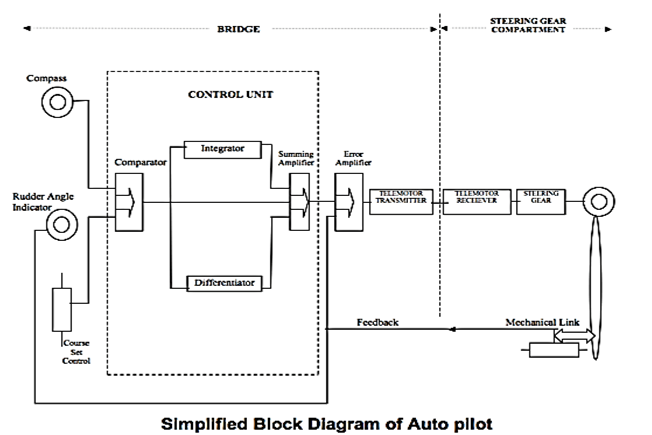The term “Radar” is an acronym for Radio Detection and Ranging”.
Principle:
A radio wave is transmitted and received back by the scanner. The time is calculated between transmission and receiving back this wave. The speed of the radio wave is known and thus the receiver unit calculates the distance of the target. After processing, it displays this information on the display screen. The rotating scanner also calculates the bearing of the target and displays on the radar screen.
IMPORTANT CHARACTERISTICS OF A RADAR .
1) VERTICAL BEAMWIDTH (VBW):
IT IS THE VERTICAL ANGLE AT THE SCANNER CONTAINED BETWEEN THE UPPER &THE LOWER EDGES OF THE RADAR SETS BEAM.AS PER THE IMO STANDARDS THE RADAR SET SHOULD FUNCTION IF THE VESSEL IS ROLLING OR PITCHING +_10 DEG WITHOUT DETERIOATION.
MARINE SETS HAVE A VBW OF 15-30 DEG.
2) HORIZONTAL BEAM WIDTH (HBW):
IT IS THE HORIZONTAL ANGLE AT THE SCANNER CONTAINED BETWEEN THE LEADING & THE TRAILING EDGE OF THE RADAR BEAM .IT CAUSES ALL THE TARGETS TO APPEAR LARGER IN AZIMUTH BY AN AMOUNT EQUAL TO HLF THE HBW.
3) PULSE LENGTH:
DUE TO THE PULSE LENGTH THE POINT OF THE PPI APPEARS TO HAVE A RADIAL DEPTH OF HALF PL IN METERS.IT IS THE TIME INTERVAL BETWEEN THE TIME TAKEN BY THE PULSE TO LEAVE 5HE LEADING AND THE TRAILING EGDES.
4) PULSE REPITION FREQUENCY/(PRF):
IT IS THE NUMBER OF PULSES SET OUT THROUGH THE SCANNER IN ONE SECOND. IT ISBETWEEN 500-4000.LONGER RANGES HAVE LOW PRF.SHORTER RANGES NEED HIGH PRF FOR BETTER PICTURE RESOLUTION.
5) WAVELENGTH:
AFTER RADAR ENERGY LEFT THE SCANNER THE PATH ENERGY &TRABEL ARE INFLUENCED BY :1)ATTENUATION, 2)DIFFRACTION.
X BAND: 3CM WAVELENGTH.(9300-9500 MEGS)
S BAND :10 CMS WAVELENGTH.(2900-3100 MEGS)
3CM :GREATER ATTENUATION ,LESS DIFFERENCE ,GOOD FOR SHORT RANGES.
10 CM: LESS ATTENUATION, MORE DIFFERENCE,GOOD FOR LONGER RANGES.
LIMITATIONS OF RADAR SET:
1)RANGE DISCRIMINATION:
IT OIS THE ABILITY OF THE RADAR SET TO CLARLY DISTINGUISH TWO SMALL TARGETS ON THE SAME BEARING AT SLIGHTLY DIFFERENT RANGES.
THE DISTANCE BETWEEN THE TWO TARGETS IS EQUAL TO OR LESS THAN 1/.2 PL.
2)BEARING DISCRIMINATION :IT IS THE ABILITY OF THE RAAR SET TO CLEARLY EXTINGUISH TWO TARGETS OF THE SAME RANGE AND SLIGHTLY DIFFERENT BEARINGS.FACTOR:HBW.
3)MINIMUM RANGE:
A) THE PULSE LENGTH :THE TR CIRCUIT PREVENTS THE TX OF ANY SIGNAL BEFORE RECEIVING IT.HENCE,THE THEOROTICAL MINIMUM RANGE OF DETECTION IS REPEATED BY HALF PL IN MINUTES.
A PL OF 0.2 MICRO WOULD HAVE ARANGE OF 30 MTRS.
B) DEIONISATION DELAY: A SMALL DELAY OCCURS IN THE TR CELL BETWEEN THE COMPLETION OF TX &RECEIVING. A DELAY OF 0.5 MICROSECS.WOULD INCREASE THE MINIMUM RANGE A FURTHER BY 7.5 MTRS.
C)THE VBW +THE HEIGJHT OF THE SCANNER.
4)MAXIMUM RANGE:
A)HEIGTH OF THE SCANNER INCREASES THE SCANNER , THE INCREASE OF RANGE.
B) POWER OF THE SET ,MARINE RADAR SET TRANSMITS AROUUND 25 TO 60 KWTS.
C) WAVELENGTH : 10 CMS HAVE EXTENDED RANGE AS COMPARED TO 3 CMS.
D) PULSE REPETION FREQUENCY:
E) PULSE LENGTH: LONG PULSES ENSURES BETTER MAXIMUM RANGES THAN SHORTER PULSES CAUSE ,LONG PULSES HAVE MORE WAVELENGTH IN THEM.
F) VBW/HBW:THE NARROWER THE BEAM WIDTH THE GREATER THE DIRECTIONAL CONCENTRATION,INCREASES THE RANGE.
5)ANOMALOUS PROPOGATION: SUPER REFRACTION CAUSES AN INCREASE IN MAXIMUM DETECTION RANGE. THIS IS CAUSED DUE TO METEOROLOGICAL FACTORS LIKE TEMPERATURE INVERSION.
RANGE ACCURACY: ACCORDING TO IMO PERFORMANCE STANDARDS THE ERROR IN THE RANGE OF AN OBJECT SHOULD NOT BE MORE THAN 1.5% OF THE MAXIMUM RANGE SCALE IN USE OR 70 MTS WHICHEVER IS THE GREATER.
BEARING ACCURACY: ACCORDING TO THE IMO PERFORMANCE STANDARDS THE OBJECT SHOULD BE MEASURED WITH +_ 1 DEGREE OF ACCURACY.
THE FOLLOWING ARE THE MERITS/DEMERITS OF USING HEADS UP MODE / NORTH UP MODE:
HEADS UP DISPLAY:1)
PICTURE SMUDGES IN AZIMUTH DURING ALTERATION OF COURSE.
2)
BECAUSE OF SMUDGING ACCURATE BEARINGS CANNOT BE TAKEN AT THAT TIME.
3)
PLOTTING TENDS TO BE HIGHLY INACCURATE DURING SEVERE YAWS.
4)
ALL BEARINGS ARE RELATIVE.
5)
RADAR PICTURE IS HEAD UP WHILE CHART IS NORTH UP.
6)
AFTER LARGE ALTERATIONS OF COURSE THE OBSERVER TENDS TO GET DIS- ORIENTED WITH PLOTTING AS ALL TARGETS HAVE SHIFTED.
7)
NO INDICATION ON THE SCREEN OF GYRO COURSE STEERED.TEMPORARY WANDERINGS MAY GO UNDETECTED.
NORTH UP DISPLAY:1)
PICTURE DOESN’T SMUDGE IN AZIMUTH AND BEARINGS CAN BE TAKEN ACCURATELY.
2)
PLOTTING IS QUITE ACCURATE EVEN DURING HEAVY YAWS.
3)
ALL BEARINGS ARE TRUE.
4)
CHART AND PPI. BEING NORTH UP IT IS EASIER TO RELATE.
5)
THERE IS NO DISORIENTATION DUE TO ATERATION OF COURSE.
6)
HEADING MARKER INDICATES THE GYRO COURSE STEERED AT ALL TIMES.
Advantages of RADAR:
1. Used at night and during periods of reduced visibility when visual means of navigation are limited or impossible.
2. Available at greater ranges from land.
3. Fixes may be obtained from a single object.
4. Fixes obtained quickly & accurately.
5. Can locate & track shipping and storms
Disadvantages of RADAR:
1. Subject to mechanical & electrical failure.
2. Both min & max range limitations.
3. Interpretation of display is not always easy.
4. Bearing LOP’s are inaccurate.
5. Small objects may not be detected in highseas.
Radar Performance test checks the transmission and receiving power of the radar. For example if the transmission power of the radar is not enough, radar may not be able to paint some of the target at all. Or radar may only be able to paint the targets with very less sensitivity (faint echoes).
What are controls of RADAR?1.
Brilliance
2.
Focus
3.
Gain
4.
Tuning
5.
Anti sea clutter
6.
Anti rain clutter
What are APPA alarms/list of ARPA alarms?
1. Guard zone alarm.
2. Danger target alarm.
3. Lost target alarm.
4. ARPA malfunction
.



.png)
.png)
.png)














